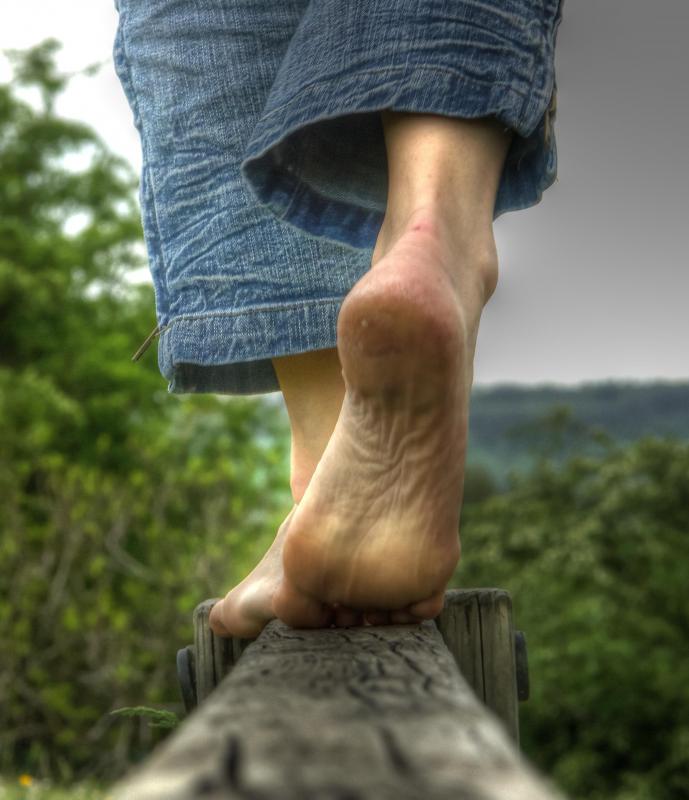At TheHealthBoard, we're committed to delivering accurate, trustworthy information. Our expert-authored content is rigorously fact-checked and sourced from credible authorities. Discover how we uphold the highest standards in providing you with reliable knowledge.
How do I Fix Poor Balance?
Poor balance is a common occurrence in both active and sedentary people. Balance is the ability to shift your weight and remain upright. There are four possible causes for poor balance: weak core muscles, bad posture, reduced leg strength, and inner ear problems.
The core muscles of the human body are the stomach, abdominal and back muscles. These muscles hold the body upright and have both large and small muscles that work together to support the body. There are several exercises available to fix poor balance. They are all easy to do and provide quick improvement.
The first exercise to improve your balance is to strengthen your back muscles. Stand up and stretch to your full height. Tuck your bottom in by tilting your pelvis in and up. Release and repeat. Feel the movement in your lower back.
To improve your core muscles, complete sit-ups and abdominal crunches to strengthen these muscles. Alternate between back and stomach muscles for 10 days, with at least 20 repetitions per day. You will feel your balance and strength improving.

Posture is the upright position of the body. Good posture occurs when you can draw a straight line from your ear, through your shoulder, hip and ankle. Stand in your normal posture and look sideways at yourself in a mirror. If you have poor posture, your hips are out of alignment. To correct this, move your body until it is a straight line.
Practice holding this position as you stand, walk and sit. Proper posture makes you appear leaner, allows you to move with more freedom and creates an image of physical health and vitality. By maintaining an upright posture, your core and leg muscles are working and strengthening all day.

Improve your leg strength to help stabilize your body. The exercises to improve your leg strength are basic exercises that can be completed at any time. Stand up to your full height, with your hands resting on the back of a heavy chair or a tabletop. Take one leg and lift it off the ground, moving your knee up to a 90-degree angle. Hold this position for a count of 15. Put your foot back down and repeat with the other foot.
For an additional challenge, take one hand off the chair and then take both hands off. Keep your head up and look at a point parallel to the level of your eyes. This will improve your posture and help to fix poor balance.
Inner ear infections or damage has a direct impact on your balance. The fluid level inside the inner ear is responsible for our sense of balance. If you have continual problems with your balance, see your doctor and discuss your inner ear concerns.
AS FEATURED ON:
AS FEATURED ON:

















Discussion Comments
This is helpful. I have neuropathy of my spine so my balance is very poor. I need a lot of help.
I agree with anon, that these sorts of "how to" articles really miss the boat when a person has balance issues unrelated to the basic core and leg muscle strengthening.
I have optic nerve hypoplasia and as a result, have very low vision from just one eye (so monocular vision). I am also a yogi and have been for over 30 years. I practice balancing poses regularly, yet I completely suck at them! I would like to see some discussion of (perhaps even simple - or not so simple - recognition) of the fact that balance is not all about strengthening muscles. There is so much more to it. The chronic focus on the remedial sorts of muscle strengthening exercises to improve balance are just, well, remedial. We can think deeper than just muscles, I think!
Eh, not quite. You can also have permanent balance problems due to limbic system lesions or other forms of brain damage. (I have severe basalar migraine, which has caused this.) I got here after looking for info on which activities were good for people with permanent balance problems, like for fun, not therapy?
All I get over and over is the same set of "exercises" that I can't do -- ever, and which are boring as well as dangerous. How come there's nothing about living with bad balance? All that's on line is how (for some people) to try to make it go away. Life isn't all therapy, folks, and some of us will never be "fixed."
Post your comments